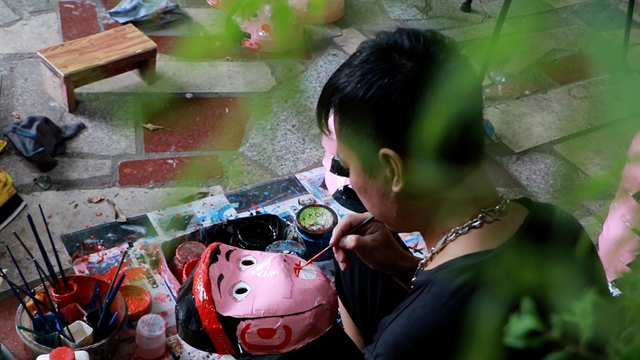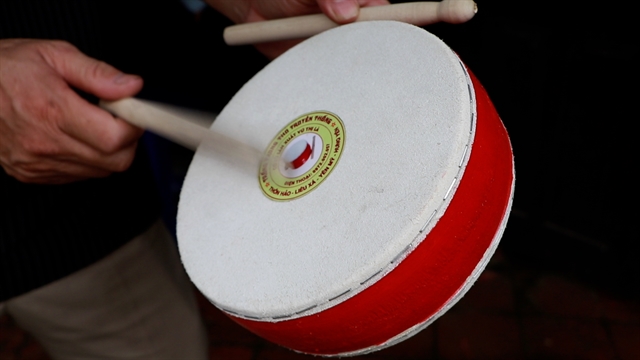 Sunday/Weekend
Sunday/Weekend

Minh Phương
Just an hour from central Hà Nội, Ông Hảo Village in Hưng Yên Province is buzzing with activity as locals prepare for the Mid-Autumn Festival.
The village is awash with vibrant colours and the distinctive scent of paint and wood as villagers continue their generations-old tradition of making paper masks and drums for the festival, a time for family reunions and children's celebrations, which take place on the full-moon night of the 15th day of the eighth lunar month, which falls on September 17 this year.
Preserving traditions
In a courtyard spanning 40 square metres, Vũ Huy Đông and his wife work diligently, completing hundreds of papier mâché masks to be sold across the country.
Đông is the second generation in a family that has been making Mid-Autumn Festival toys for three generations. For over 40 years, he and his wife have carried on the family tradition, now passing the craft to their son.
For Đông, a love for children is the key to keeping the tradition alive.
“Only when you love your job can you continue and dedicate yourself to it for a long time,” he said. “And you have to love children. Only when you love them will they enjoy the toys you make. If you don't, you won’t be able to do this job.”
His son, Vũ Huy Đảm, shared his father’s passion for the craft.
“I am very proud that our village has preserved this folk craft,” Đảm said. “We strive to keep it alive, so children can enjoy a meaningful Mid-Autumn Festival.”
Every year, during the sixth and seventh lunar months, Đông’s family becomes incredibly busy producing toys for the event.
“The products are sent to many places across Việt Nam,” Đông said.
Creating a papier mâché mask isn’t particularly difficult, but it does require skill and meticulous attention to detail.
Designs have to evolve to keep up with changing customer preferences, ranging from Vietnamese folk-tale characters to modern designs. Popular masks for children include lions, monkeys and other animals.
“During my father’s time, papier mâché masks mostly depicted male and female characters, and were used for lion dance troupes during the Mid-Autumn Festival,” Đông said. “But as children’s interests grew, I had to create new designs.”
The mask-making process is time-consuming, with each piece crafted by hand. Throughout the year, artisans prepare the base shapes in advance, so the masks are ready to be painted in time for the festival.
 |
| Vũ Huy Đông creates the mask by layering paper and white cardboard together with glue. VNS Photo Minh Phương |
“Whether making an animal or a human figure, the process starts with a cement mould. Once the mould is made, it can be used to create multiple papier mâché masks,” he said. “We use glue made from cassava starch mixed with water to paste paper masks.”
“After being formed, the masks are dried in the sun, then painted. The painting process involves applying three or four layers, with each layer drying before the next can be added.”
The final step is drawing the details, such as facial expressions or hair, which requires a steady hand and artistic skill.
“This is the most important step, as the artisan needs to highlight the details to match the character,” Đông added.
 |
| Painting the paper masks requires an artistic skill. VNS Photo Minh Phương |
While Đông’s family specialises in paper masks, Vũ Thị Là's family have been making drums for years. They produce dozens of drums daily, using natural materials like wood and leather.
Making a toy drum requires more skills, including sawing the wood to make a wooden shell, and stretching the leather over the drum head.
“If the shell isn’t perfectly round, the leather won’t stretch properly, and the sound won’t resonate,” Là said.
Her family’s drums have earned 3-star "One Commune, One Speciality Product" recognition, showcasing their passion and craftsmanship.
 |
| The wooden shell must be perfectly round to properly stretch the leather over the drum head, ensuring good sound quality. VNS Photo Minh Phương |
Time-honoured crafts
Today, only a handful of households in Ông Hảo Village continue the ancient crafts, with most artisans over 50 years old.
“Around 10 households in the village still practise the crafts. Financial challenges have deterred younger generations, but compared to two or three years ago, when traditional Mid-Autumn toys were at risk of disappearing, the crafts have regained their foothold," Văn Đức Toản, the village chief, said.
“This is a positive sign, attracting younger people to return and help preserve the village’s traditional crafts. Đông’s family is a shining example of passing down these values to the next generation.”
Master artisan Đông is proud to keep the ancient tradition alive.
“My family makes over 10,000 masks and 8,000 drums annually,” Đông said.
“In recent years, there has been a resurgence of interest in traditional values, which has boosted demand for paper masks and toy drums. I believe our crafts will not only survive but thrive in the future.”
Even though more modern plastic and metal toys have flooded the market, artisans remain confident in the enduring appeal of their traditional crafts.
“Children today appreciate traditional Vietnamese toys,” Là said. “In recent years, we’ve sold a great deal of toys. In fact, we can’t keep up with demand.” VNS




